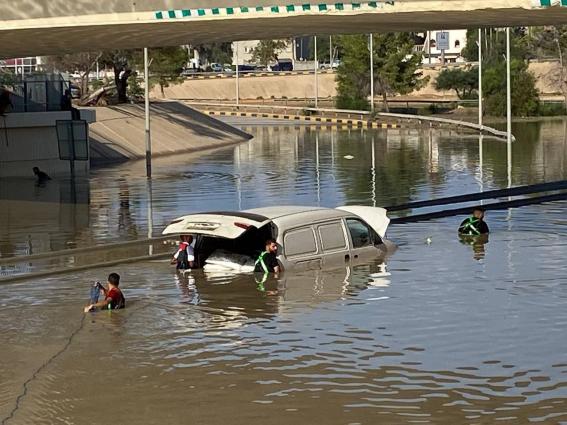
Photo source: WMO
Tripoli: Since the disaster struck Libya on September 10, 2023, 4014 people have been reported killed and over 8500 remain missing in catastrophic floods that had a devastating impact on the country’s east coast. Search and rescue teams have managed to dig 452 survivors out from the rubble of collapsed buildings. Between 30,000 and 35,000 people displaced by the floods are currently residing in overcrowded camps and settlements in the Derna governorate, where they have limited access to clean water and sanitation.
Most of the health risks for flood survivors stem from the presence of contaminated water and poor hygiene and sanitation facilities. Risks include the threat of waterborne disease outbreaks such as acute watery diarrhoea and cholera, and vector-borne disease outbreaks such as typhoid fever, dengue, malaria and yellow fever.
The environmental situation remains challenging with the proliferation of disease vectors such as flies and mosquitoes. Stagnant water, particularly in Al-Makhili, Derna and Soussa, is a breeding ground for mosquitoes and creates conditions conducive to the spread of malaria and waterborne diseases. According to the Libyan National Centre for Disease Control (NCDC), 238 cases of diarrhoea were reported between September 14 and 18, 2023.
These challenges are compounded by disrupted healthcare services, especially for vulnerable groups such as children, women and patients with chronic diseases.
Tens of thousands of people have lost loved ones, homes, livelihoods and all their belongings, putting them at significant risk of acute mental distress.
“The magnitude of this catastrophe is staggering,” said Dr. Ahmed Zouiten, the World Health Organization (WHO) Representative in Libya. “The need for swift, unified action cannot be overstated. We are collaborating closely with our partners, national authorities and the international community to deliver vital aid, save lives and reinstate essential health care services during this profoundly challenging period,” Dr Zouiten averred.
WHO has allocated US$2.3 million from its Contingency Fund for Emergencies to help fund the immediate response. WHO has appealed for another US$11.1 million in the recently issued United Nations Flash Appeal. The Central Emergency Response Fund and the Government of Germany have pledged US$3 million and US$1 million, respectively.
A United Nations interagency team, too, has assessed the affected areas and identified four priorities: providing clean water, preventing disease outbreaks, restoring primary health care services and establishing mental health and psychosocial support for survivors.
WHO stated it is taking swift action to assist affected communities. WHO is supporting urgent efforts to restore access to health care and control the spread of infectious diseases, especially among the tens of thousands of people who have been displaced and are now living in shelters.
WHO has so far assessed 78 health facilities (24 hospitals and 54 primary health care facilities). More than half were reported as either being closed or not functioning due to damaged infrastructure and shortages of staff, medicines, supplies and equipment. The districts of Derna, Al-Jabal Al-Akhdar and Al-Marj were among the worst hit.
The Libyan Ministry of Health (MoH) and WHO are working to restore functionality in 10 health facilities and establish six field hospitals. A 100-bed field hospital with 10 intensive care beds, radiology services and an obstetrics and gynaecology department has been set up in Derna. In Assahel city in Al-Jabal Al-Akhdar, WHO has deployed a mobile clinic to serve Al-Bayada village, where the only rural hospital has been damaged and forced to close. WHO has also provided chronic disease medicines to primary health care centres in AlBayda, AlMarj, Derna, Shahat and Sousa.
On September 21, 2023, a team from WHO headed by Dr. Zouiten met with the health authorities in Derna to review the most urgent needs. Following this, WHO said mental health and psychosocial support services will be prioritized in the affected communities, with services ranging from “psychological first aid” through the primary care system to specialized psychiatric care for the deeply traumatized people. WHO has further intensified efforts to deploy trained mental health professionals and resources. Beyond addressing immediate physical threats, these specialists will focus on helping survivors deal with loss, anxiety, depression and post-traumatic stress disorders.
The NCDC is leading disease surveillance efforts with support from WHO. This includes active surveillance in hospitals, health facilities and shelters for displaced people so that possible outbreaks may be detected early and control measures launched immediately.
WHO said it is actively engaging with affected communities to communicate the main health risks following the floods and explain how people can help protect themselves against water- and foodborne diseases. Awareness campaigns by WHO and health partners have emphasized the dangers of drinking water from unknown sources and promoted the use of bottled water. Health education leaflets have been distributed to raise awareness of how communities can protect themselves against diseases such as malaria, hepatitis A, dengue, typhoid and cholera. WHO has also explained how people can help other survivors by providing basic psychological first aid.
WHO said it continues to communicate the above information through the MoH, NCDC and WHO-run social media platforms and local media outlets.
– global bihari bureau





